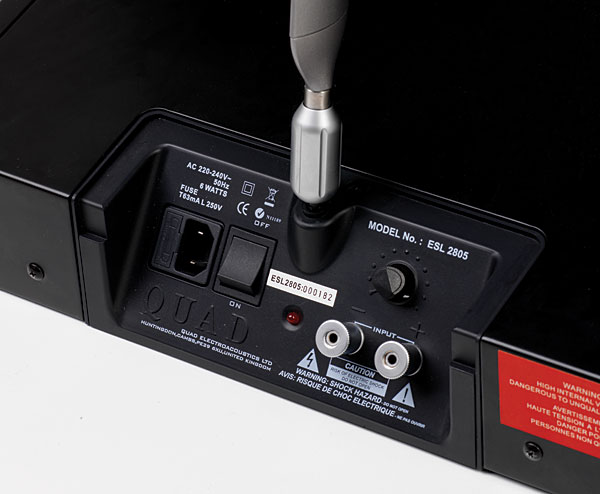| Columns Retired Columns & Blogs |
Your review was an absolute pleasure to read - a lot of interesting details and insight into what has made this speaker so special for so many years. Thanks!
And if the recording has captured the appropriate interchannel phase information, a pair of good speakers will also throw an image outside the space defined by the speaker positions. This the Quads managed with fetishistic ease: the arboreal effects that begin the first cut on Andreas Vollenweider's "Behind the Gardens–Behind the Wall–Under the Tree," from the CD of that title (ALAC file, ripped from the original 1985 Swiss CD), were positioned way outside the speaker edges.
The Quads' soundstage depth was equally impressive. In his cover of Randy Newman's "I Think It's Going to Rain Today" (ALAC file, ripped from Scratch My Back, CD, Real World 1), Peter Gabriel sings with a very close, almost conversational sound. The contrast between the image of his voice and the clearly defined tinge of ambience around the accompanying piano was maximally delicious through the ESL-2805s, pushing the instrument back in the stage.

It was the same with my recording of Bob Reina's jazz quartet Attention Screen, which I recorded live in Manhattan in 2010 for Takes Flight at Yamaha (24/88.2 master AIFF for the CD release, Stereophile STPH021-2), particularly the spacious-sounding space jam "Ear Topology." Through the ESL-2805s, the different characters of the delay pedals used by Don Fiorino on his Fender Stratocaster and Chris Jones on his fretless Jazz Bass contrasted with the wash of luminous ambience I had added with Metric Halo's Haloverb engine to tie the mix together. And when Mark Flynn works his way around his drum kit, the time-slicing Quads unambiguously preserved the spatial qualities of which drum and cymbal was positioned where without detracting from the overall picture. The track ends with Chris hitting a decaying, repeated-echoed treble lick on his bass. When I mixed this track, as Chris flicked the lick, I panned the bass from the center of the stage to audience right while leaning on the Reverb Return fader. What I wanted was the impression that the bass was taking flight and soaring back to the upper right of the stage. And that's exactly how the Quads presented it, more clearly defined than when I'd mixed it.
I haven't commented on the Quad's having a signature to its sound. That's because it had no midrange coloration. Yes, the top octaves sounded slightly sweet, and perhaps there was a touch of edge in the mid-treble, but I couldn't get a consistent handle on the latter aspect of the speaker's sound. Almost all the time, and especially when driven by the class-A Lamm M1.2 monoblocks, everything just sounded right. For example, our "Recording of the Month" for February 2003, Beethoven's Complete Violin Sonatas performed by Augustin Dumay, accompanied by pianist Maria João Pires (ALAC files ripped from CD, Deutsche Grammophon 471 495-2), has been in heavy rotation the past few years, especially Sonata 10 in G, Op.96 No.1, a work I had grown familiar with from the superb 1987 Wilson release with David Abel and Julie Steinberg (LP, Wilson Audiophile W-8722). But the Dumay performance is the one that speaks to my soul, perhaps because of Pires's sympathetic accompaniment, with a perfect echoing of the first movement's evocative trill figures on the violin. Not only were both instrumental colors correct; although the piano is in a more reverberant space than the violin, the ESL-2805s made it clear that the piano was still in the same space as the one enveloping the violin, just set farther back within that space.
A final note: from the first notes of music, it was obvious that the ESL-2805 is significantly less sensitive than average, mandating higher-than-usual volume control settings on the preamplifier. In the ESL-2805's manual, Quad cautions against playing music at sustained high levels, specifying the peak level for undistorted output as 40V and the permitted peak input as 55V. A peak voltage of 40V is equivalent to an RMS voltage of 28.3V, which in turn is equivalent to 100W into 8 ohms. I never had any problem getting sufficient loudness from the Quads with the 100W Lamm amplifiers in my 2800-cubic-foot listening room, but if your room is much larger than that, you might run up against the Quad's limit.
Summing Up
When I was discussing the qualities of this speaker with Stephen Mejias before committing my thoughts to paper, he perceptively asked what music I'd been playing. Even as I answered—"Chamber music, soft rock, classical orchestral, acoustic jazz"—I got the point. All audio products push you toward music that plays to their strengths, and yes, with the ESL-2805 I had unconsciously avoided high-intensity rock. But with that proviso, Quad's Reference ESL-2805 is very much an "exit-level" speaker. Although these samples will have been returned to the distributor long before you read these words, purchasing a pair of ESL-2805s is definitely on my bucket list.

Your review was an absolute pleasure to read - a lot of interesting details and insight into what has made this speaker so special for so many years. Thanks!


The US importer, Taiga LLC has closed shop. At this time, Liberty Trading, run by May Audios' Canadian counter-part is the sole NA importer. Also, prices have increased.

This may be a moot point since no one seems to be paying attention to these speakers these days. I have had quality problems with the Quad 2805 speakers made in China. I had to return the speakers to the manufacturer three times and the problem is still not resolved, and they want to charge me for repair. I find it incredible that the manufacturer would not take back a clearly defective product.